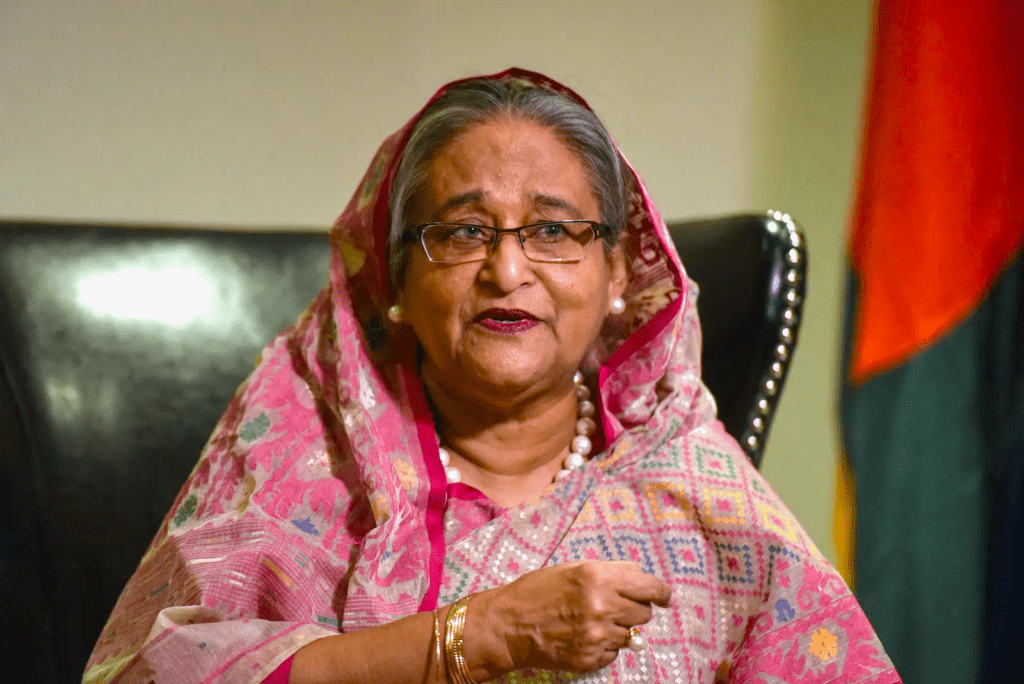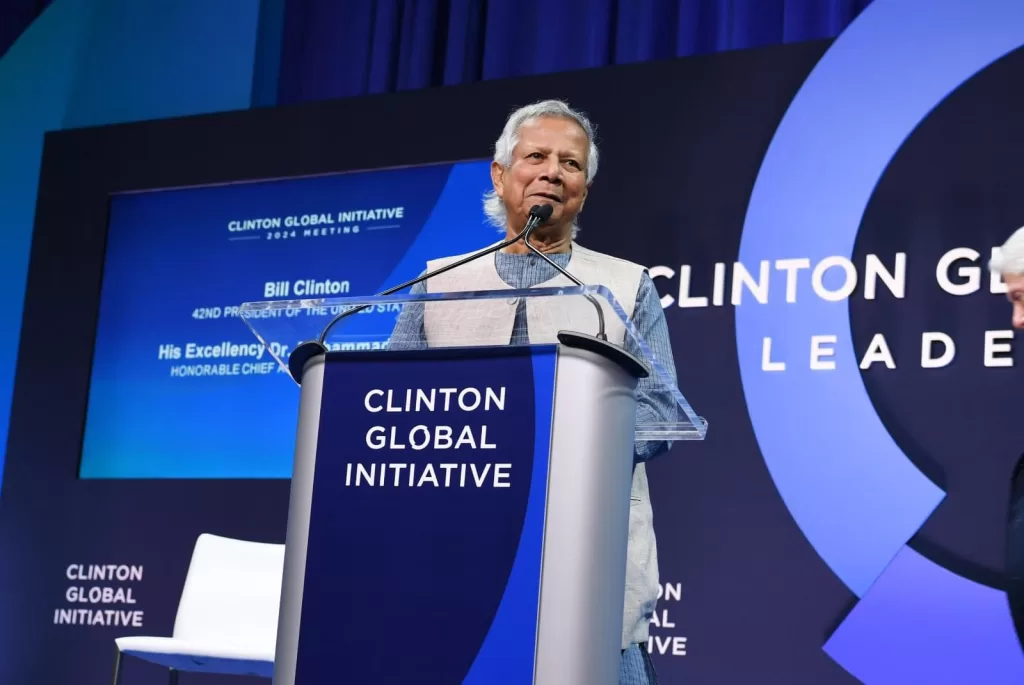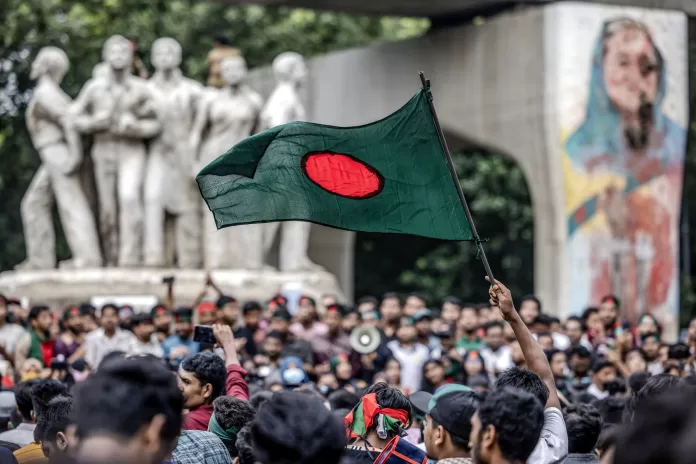The remarkable story of Bangladesh connects its regal past to the present. Bengal was the richest princely state of Mughal India with a sophisticated culture and civilization. The defeat of the youthful Nawab Siraj-ud-Daula of Bengal in 1756 established the rule of the East India Company in India. British historians admit to brutal British policies designed to destroy the fine Bengali textile industry to develop the inferior British textile industry. Amartya Sen, the Bengali-Indian Nobel Laureate, concluded with his research that the Bengal famine of 1943 – which caused three million deaths – was solely due to British policy failure. Poverty, starvation, floods and famine became the fate of prosperous and culturally sophisticated Bangladesh due to British colonialism.
Calcutta in Indian Bengal — partitioned during the independence of Pakistan and India — was the poster child of destitute India, thanks to the optics of Mother Theresa’s internationally acclaimed charity work. Awami League’s Mujeeb-ur-Rehman exploited genuine Bengali grievances about resource allocation to create resentment and ultimately an armed uprising in then-East Pakistan. Mujeeb’s collusion with India and the resulting war of 1971 led to the break-up of Pakistan.
Mujeeb hailed as Bangabandhu or father of the nation, flew to India — before heading to the newly formed state of Bangladesh — where he was received at the airport by PM Indira Gandhi and other key Indian officials. Mujeeb addressed a large crowd thanking India for its support in creating Bangladesh.
This was an ominous start for the newly created country. Between 1972 and 1974, Bangladesh and India signed 13 bilateral agreements in trade, telecommunications, oil, culture, passports and visas. Mujeeb’s death ended the golden chapter in India-Bangladesh’s relations.

Bangladesh was financially poor but intellectually wealthy and hence inclined to social justice which it sought in socialism. Mujeeb was turning out to be a dictator as he turned Bangladesh into a one-party state. Mujeeb created the Jatiya Rakkhi Bahini (JRB), a controversial militia personally loyal to him. His autocratic ways, corruption and nepotism caused a few junior army officers and noncommissioned officers to assassinate not just him at his residence, but also almost his entire family. His daughter Shaikh Hasina was then in Germany and hence lived to assume power four decades later.
After the creation of Bangladesh in March 1972, the then US Secretary of State Henry Kissinger called the country a ‘Basket Case’ as it was considered to be a non-viable state. After Mujeeb, Bangladesh saw political turmoil and a leadership crisis with a series of military coups and presidential assassinations. It is worthwhile to note that under military rule, Bangladesh shunned India. Bangladesh-India’s relations reached their lowest point during Prime Minister Khaleda Zia’s rule from 2001-2006.
While Bangladesh was facing leadership and financial crises during the 1980s and 1990s, one man was tirelessly working to bring about a silent revolution in his country. That man was Dr. Muhammad Yunus, the Nobel laureate who is presently the Chief Advisor of Bangladesh. Yunus was an Assistant Professor of Economics at the Middle Tennessee State University in the US in 1971. He could have led a cosy life in the West, teaching and romanticizing the various economic systems of Marxism, communism and capitalism, within the ivory towers of academia. Instead, he led a movement for the creation of Bangladesh while being based in the US in December 1971. Yunus then returned to Bangladesh, first becoming an academic where his fieldwork led him to discover the problems of impoverished rural women.

Yunus pioneered microcredit to bring relief to rural Bengali women caught in the vicious debt traps of money lenders. An optimal socio-economic tool for upliftment, microfinance initiatives in rural Bangladesh freed the poor from generational debt and empowered the local women. In Muslim states, the Islamic clergy actively preaches keeping women housebound, infantilized, voiceless and devoid of agency. Misogyny and oppression masquerades are religiously mandated patriarchy within the Islamic world.
Yunus’ microcredit work in remote rural households increased female literacy and integrated the women into society as equal citizens with rights and responsibilities. No country can progress if its women remain uneducated, housebound and outside the socio-economic framework. The shift in women’s attitudes is the foundation of the socio-economic development in Bangladesh. In the arena of women empowerment and the global gender gap index 2024, Bangladesh ranks 99, India 129 and Pakistan 145 out of 146 countries.
The success of Yunus’ microcredit initiative led to the state seeking his assistance in the fisheries sector, where the harvest was dismally low due to corruption-prone lower bureaucracy incapable of efficient management.
Yunus lacked any knowledge of fisheries but his Grameen Foundation brought in a new management style, new determination, and a new drive, exponentially raising the initial 50 tons yield to 805 tons in 1993. Yunus established the Grameen Fisheries Foundation, whose key feature was the social-consciousness-driven entrepreneur.
True progress only happens after changing mindsets. Systemic and structural flaws inherited from colonial rule led the people to despondency and a complete lack of agency. No economic planning can succeed if individuals do not feel driven and empowered. The belief that every citizen has a stake in his country’s future has to be nurtured through community engagement and equitable resource allocation. Grameen fisheries shared the yield equally between the poor workers and the state. This resulted in zero theft and a rich harvest.
Bangladesh is a country that does not produce cotton, yet Yunus reconnected Bangladesh’s glorious textiles past to its present. Bangladesh was classified as a Least Developed Country (LDC) by the UN, this status allows preferential trading terms (lower tariffs and higher quotas) by countries in the EU.
Bangladesh focused on the garments export industry, following the growth trajectory of the now prosperous Asian countries such as South Korea, Hong Kong, Thailand, and China. Today Bangladesh is the world’s second-largest apparel exporter, trailing behind China. Garment exports stood at $38.5 billion in 2024 and Bangladesh’s total export earnings in 2024 were $44.4 billion. Yunus went on to establish the Grameen Agriculture Foundation and Grameen Krishi Foundation, an irrigation project. Yunus’s work extends to the major sectors of healthcare, nutrition, textiles, education, energy, telecommunication, ICT, food production and internet services. He established a total of 54 social businesses and these very sectors are the growth engines of the Bangladesh economy today. Grass root level organic change transformed the country.

The Oxford Internet Institute states that Bangladesh has a 16 percent share in providing online labour, second only to India, which holds a 24 percent market share. Interestingly, the US ranks third with a 12 percent market share. As per government data, 650,000 registered online freelancers bring in USD 500 million to the Bangladesh economy. Bangladesh has also registered growth in shipbuilding. It has exported sea vessels to New Zealand, Denmark, Netherlands, Germany, Kenya and India. The cottage industry and small and medium enterprises have thus played a role in poverty reduction. The poverty rate has decreased from 80 percent in 1971 to 18.7 percent in 2022. In 1990, Bangladesh’s Human Development Index (HDI) was 0.392. It stood at 0.67 in 2024, whereas Pakistan’s HDI stood at 0.544 and India’s was 0.644. Bangladesh has maintained a public debt-to-GDP ratio between 30% and 40% while Pakistan’s public debt-to-GDP ratio is 65.2%. Fiscal restraint has allowed Bangladesh’s private sector to borrow and invest.
From 2014 to 2023 Bangladesh’s economy’s growth rate has been 7% annually. Its GDP has increased from $31 billion in 1990 to $451.4 billion, as per the latest figures quoted by IMF’s World Economic Outlook Report 2024. Termed a “Development Miracle” this phenomenal GDP growth is owed to the sectors developed by Yunus. The service sector, including wholesale and retail trade, transport, storage, communication, real estate, renting and business activities, contributes around 51% to the GDP. Industry, primarily manufacturing and construction, accounts for approximately 34.59% of the GDP. Finally, agriculture, including forestry and fishing, contributes about 11% to the GDP.
Bangladesh’s GDP per capita in 2024 stands at $2,624.5. Pakistan stood at $1,588. India’s was $2,236.
Geographic location is both a natural boon and a bane for Bangladesh. Ports located in the Bay of Bengal handle 33 percent of global trade and half of the world’s container traffic. Additionally, the Bay of Bengal is located at a strategic chokepoint, the Strait of Malacca, connecting the Indian Ocean to the South China Sea. This chokepoint is vital because it controls maritime access to the Far East and is used by a large amount of international shipping.
This led to a US demand for a military base in St. Martin’s Island of Bangladesh. Mujeeb’s daughter Shaikh Hasina assumed power in 2009. China, India, and the US, were all contending for influence and Hasina managed a tough balancing act. The US and EU were Bangladesh’s important trading partners, while China has a broad defense agreement with Bangladesh. Dhaka inaugurated a Chinese-built naval base for the Bangladesh Navy at Pekua in 2023. Reviving the legacy of her father, Hasina also established deep ties with India.
Under Hasina’s rule, Bangladesh initiated nine infrastructure and power megaprojects. Out of the nine, China has funded five since Bangladesh has signed on to China’s Belt and Road Initiative (BRI). The Chinese projects include the $3.3 billion Padma Bridge, the $1.9 billion Pigeon Power Plant, the $1.32 billion power grid development, a $1 billion digital connectivity project, and finally, the $15 billion Payra deepsea port. Japan funded the Dhaka Metro Rail and the Matarbari deep seaport. India loaned money for the $1.6 billion Maitree Super Thermal Power Plant while Russia funded the $13 billion Rooppur Nuclear Power Plant.
Yunus had transformed Bangladesh’s socio-economic fabric. Additionally, the sea change in geopolitics and world trade brought about prosperity in Bangladesh. Hasina’s political trajectory was, however, identical to her father albeit with a modern twist.

Hasina faced criticism for making Bangladesh a one-party state. In 2007, Dr Yunus unsuccessfully tried to set up a rival political party, while Bangladesh was ruled by an interim military government. He claims that this threatened Prime Minister Shaikh Hasina. Yunus came under attack from the government over corruption charges. In 2011, the Bangladesh Central Bank ordered Dr Yunus sacked as the Managing Director of Grameen.
Hasina clamped down hard on critics, especially in the media. Mujeeb had his Jatiya Rakkhi Bahini (JRB), a controversial militia personally loyal to him and Hasina had Bangladesh’s elite paramilitary force, the Rapid Action Battalion (RAB) run a secret prison for dissidents and other opponents to her regime called “Aynaghor” (House of Mirrors).
During the last few years, there was a growing outcry about disappearances, imprisonments and missing persons under the Hasina government. During Yunus’ current interim rule, Hasina’s torture chambers and missing persons are being revealed on national TV. Hasina appointed relatives and supporters in key government positions, including the Army chief.
Reviving the legacy of her father, the Modi-Hasina regime signed 90 bilateral agreements from 2015 to 2019. Bangladesh became one of India’s important development and strategic partners in trade, investment, power, security, water, connectivity, and cultural cooperation. These developments led to the public perception that Hasina was turning Bangladesh into an Indian colony.
Additionally, Modi’s persecution of Muslims in India and his revocation of Article 370, assigning a special status to Kashmir, inflamed the religious sentiments of Bangladeshi Muslims. The combined effect was a growing anti-India and anti-Hasina sentiment in Bangladesh.
Although Bangladesh was experiencing economic growth, youth unemployment was rising. It stood at 8% when Hasina came to power in 2008 and rose to 16%. Unemployment coupled with bias in the state bureaucracy to provide loans and other benefits to private-sector leaders associated with the Awami League, led to frustrations and anger.
Hasina’s reinstatement of the Bangladesh Civil Service (BCS) quota was the straw that broke the camel’s back. Under BCS quota 30 percent of the 56 percent of reserved civil service positions were reserved for descendants of Bangladeshi Freedom Fighters (“Muktijuddhos”).
It must be understood that Muktijuddhos families had played a big role in Mujeeb’s Awami League winning the 1970 Pakistan General Elections, which had led to the 1971 war. Hasina’s BCS quota was perceived as a move to entrench the Awami League Party in the state bureaucracy.
Hasina and her Awami League were operating an electoral autocracy, which continually crushed the opposition through ballot stuffing, strong-arming the media, and voter intimidation. Prior to the January 2024 election, the Awami League faced US and E.U. scrutiny and even sanctions. However, Hasina was feeling secure after her capture of state institutions. The quota reform movement led by students was initiated in June 2024. Hasina crushed the rebellion with “shoot on sight” orders and according to a report by the Human Rights Support Society, more than 30,000 people were injured and more than 875 were killed in the collective unrest, 77% of whom had died from gunshot wounds.

While the country underwent internet shutdowns during the Quota Reform Movement and protestors were subject to “shoot-on-sight” orders by Hasina, the 100,000-strong student wing of the Awami League, known as the Chhatra League was provided arms, ammunition, and access to the internet to better coordinate their efforts in stopping the protests.
The Chhatra League had already earned much notoriety after their 2019 murder of Abrar Fahad, a dissenter whose Facebook post expressing concern over a water deal with India led to him to being killed in a Bangladeshi university. As the student rebellion turned into a mass rebellion, Hasina was ousted on August 5, 2014 and she hastily boarded an army helicopter, which took her to safety in India. Nobel laureate and social entrepreneur, Dr. Muhammad Yunus was sworn in as Chief Advisor to the Bangladesh Interim government on August 8, 2024.
Yunus had to immediately contend with lawlessness, communal tensions, difficulty for the country’s rapidly growing economy, and accountability for revolution victims. He is working hard to deliver on all these issues.
In a very positive development, Yunus and Bangladesh are displaying a strong pro-Pakistani stance in bilateral relations. From visa facilitation and the promotion of mutual trade to military cooperation, Pakistan and Bangladesh are establishing strategic relations. Lieutenant General S M Kamr-ul-Hassan, Principal Staff Officer (PSO) of the Armed Forces Division of Bangladesh arrived in Pakistan in January 2025. He held meetings with the top brass of the Pakistani military. Their discussions focused on matters
of “mutual strategic interest” and explored avenues for enhancing bilateral defence cooperation. Lt-Gen S M Kamr-ul-Hassan also met the Pakistan Air Force chief and expressed interest in acquiring the JF-17 Thunder fighter jet, a multi-role combat aircraft jointly developed by Pakistan and China, as a potential replacement for its aging F-7 and MiG-29 fleets.
India acknowledges that 1971 was India’s first military victory in 2000 years, thus the growing Pakistan-Bangladesh ties are a big blow to India, which had severed the two wings of erstwhile united Pakistan.
Bangladesh-Pakistan brotherly relations are a very positive development for both states economically, militarily, diplomatically, geopolitically, and culturally. People-to-people ties must also be nurtured for mutual progress and prosperity between the two Muslim South Asian nations.




